Palazzo Vecchio Art Story | Location | Opening Hours Tickets | Authorizations
Art Story Five-Hundred | Tower | Vasari Halls | Dante Mask | Ghirlandaio | Bronzino Sarto Daddi | Salviati | Cortile
Five-Hundred Hall Hall and Ceiling | Ceiling Paintings | Pisa War | Siena War | Sculptures
Ceiling Paintings Cosimo I Medici | Florence History | Wars and Battles | Tuscany
Paintings of the Ceiling of the Hall of Five Hundred of the Palazzo Vecchio in Florence
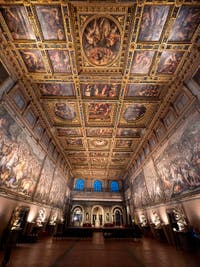
Five Hundred Hall The plan to modify the former Hall of the Five Hundred to make it the largest and most richly decorated in all of Europe dates from the end of 1559.
Vasari, encouraged by Duke Cosimo I of Medici, made a small wooden model of the project of the future hall and went to Rome to present it to Michelangelo for his opinion and advice.
Michelangelo welcomed the project but also proposed to raise the height of the room by about seven metres.
Cosimo I Medici wished to link his name to a large venture then agreed to the work, notwithstanding the considerable costs involved.
Cosimo I de Medici used to control and decide on any administrative and governmental acts concerning the Duchy of Florence.
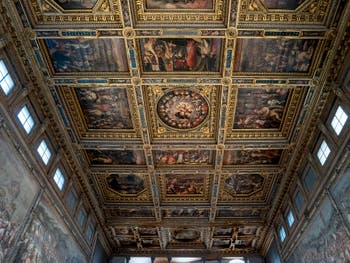
Ceiling Hall of Five Hundred This personal intervention of the Duke in the management of Florence was also present in the project of the Hall of the Five Hundred.
Numerous handwritten notes of the Duke were found in the margins of documents and letters sent by Vasari.
Cosimo I de Medici thus significantly influenced the iconographic program of paintings and frescoes, from the beginning of the project to its final realization.
For the ceiling, Vasari had made several preparatory drawings, some of which are still preserved in the Uffizi Gallery.
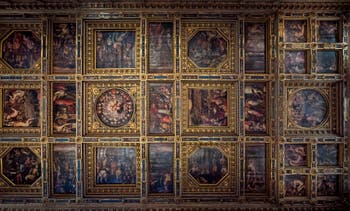
Ceiling Hall of Five Hundred He was assisted by the Flemish painter Giovanni Stradano, who also collaborated with Vasari to decorate other rooms of Palazzo Vecchio, such as those of Leo X, Eleonora, Clement VII or Penelope with the adventures of Ulysses.
Two other painters also helped Vasari produce these paintings, Giovanni Battista Naldini and Jacopo Zucchi.
On March 3, 1563, a first project containing the cycle of paintings of the coffered ceiling of the Hall of the Five Hundred was presented to Duke Cosimo I of Medici.
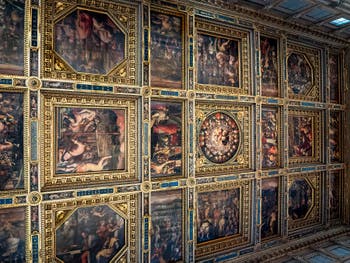
Ceiling Hall of Five Hundred This project was aimed to represent all the important events in Florence's history: From the foundation of the city by the Romans to the restoration of its greatness with Duke Cosimo I.
It also included the wars of Pisa and Siena and allegories representing the four districts of Florence, their vicariates and their campaigns, and their sixteen banners accompanied by major and minor arts.
It may be thought that the somewhat overwhelmed celebration of the republic of Florence was not entirely in the taste of the Duke.
He demanded the removal of the councillors in the representation of the deliberation on the war of Siena by replacing them with allegorical figures.
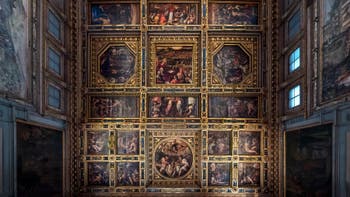
Ceiling Hall of Five Hundred The Duke also demanded that the representations of all the ducal states and domains be accompanied by a motto or a few words capable of illustrating each of them better, hence the presence of Latin inscriptions which can be read under most of them.
Finally, he demanded that certain paintings evoke the imperial and papal privileges granted to the Florentines, including those given by Clement IV, Charles IV, Charles V and Pope Eugene IV.
The political and personal character of this pictorial cycle imposed by Duke Cosimo I of Medici is particularly evident when we see the ceiling's very centre.
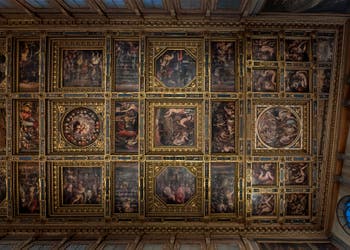
Ceiling Hall of Five Hundred Instead of showing Florence's glory, all we can see is the glorification of the Duke himself.
He is crowned by an allegorical figure of Florence with an evocative title: “The Apotheosis of Cosimo I of Medici”.
Nevertheless, this ceiling, as well as the frescoes and statues of this Hall of Five Hundred, are of incomparable splendour thanks to the talent of Vasari and the genius of Michelangelo and his idea of raising the height of this room, which makes it all the more impressive when you enter.
We present to you in the following pages the details and meaning of the paintings of the ceiling of the Hall of the Five Hundred:
- Glorification of Cosimo I of Medici
- Allegories of the history of Florence
- Wars and Battles
- Allegories of Tuscany
Ceiling Paintings Cosimo I Medici | Florence History | Wars and Battles | Tuscany
Five-Hundred Hall Hall and Ceiling | Ceiling Paintings | Pisa War | Siena War | Sculptures
Art Story Five-Hundred | Tower | Vasari Halls | Dante Mask | Ghirlandaio | Bronzino Sarto Daddi | Salviati | Cortile
Palazzo Vecchio Art Story | Location | Opening Hours Tickets | Authorizations
Back to Top of Page

